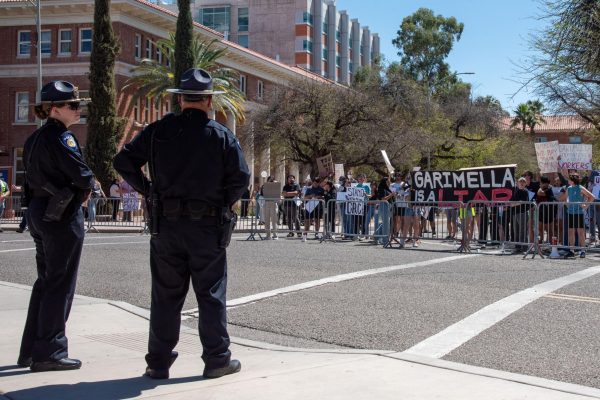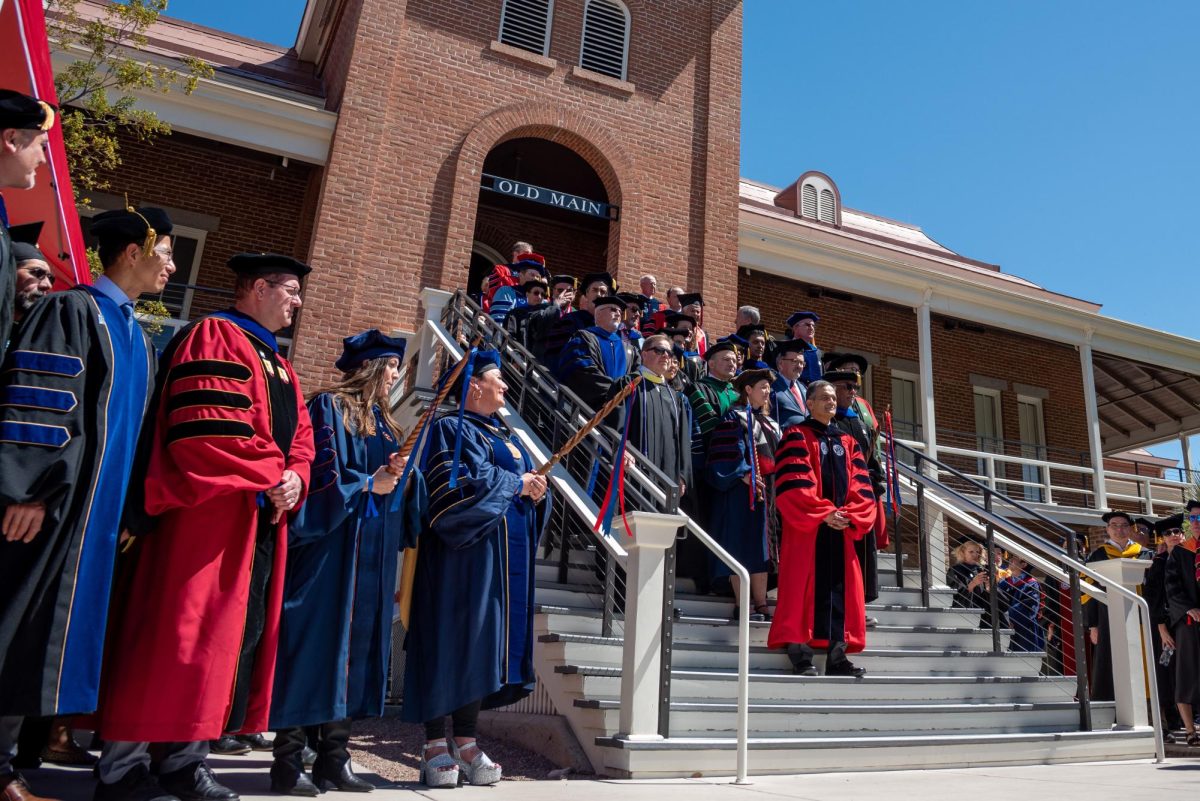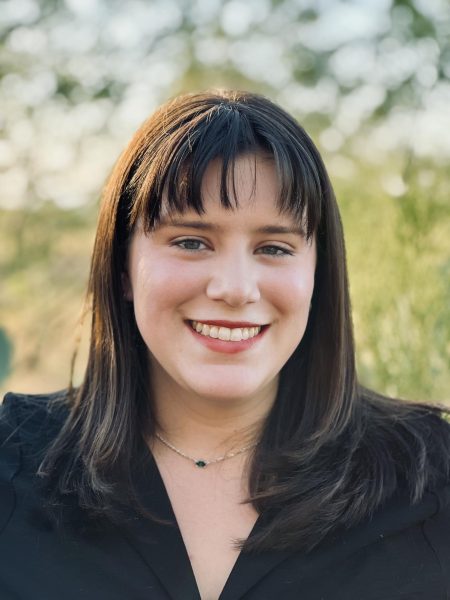The Presidential Installation Ceremony
The installation ceremony began on the front steps of Old Main with the presentation of colors, the national anthem and the blessing of the Seven Sacred Directions from Assistant Dean and Associate Professor of the College of Medicine Carlos Gonzales.
Student demonstrators from the Coalition to Protect Students and Workers gathered outside the barricade around Old Main. Many of the students’ chants projected and concealed the opening remarks.
After regards from Gonzales and Interim Senior Vice President for Academic Affairs and Provost Ronald Marx, the presidential party was led by the Pride of Arizona Marching Band to Centennial Hall, where the installation ceremony was officially held.
Members of Garimella’s presidential party, including Arizona Governor Katie Hobbs, Tucson Mayor Regina Romero, Oro Valley Mayor Joe Winifield and Sahuarita Mayor Tom Murphy, were joined on stage for the installation.
Hobbs gave remarks following Marx to start the ceremony.
“As Arizona’s land grant University, UA was established with the purpose of removing barriers to higher education and operating a path forward for everyone in Arizona. The university has demonstrated a commitment to serving Arizona’s diverse population and has earned recognition as a Hispanic-serving institution and an American Indian and Alaska native-serving institution,” Hobbs said. “The land grant mission means a lot to the university, as it does to Dr. Garimella. His passion and enthusiasm to be of service to the state are evident.”
Leila Hudson, associate professor of Middle Eastern and North African studies and faculty chair, spoke at the Centennial Hall procession on trust and presidential expectations.
“We trust that he will keep our campus safe for all, from violence, including state violence, that he will provide the meaningful support that each and every student needs to realize their educational potential,” Hudson said. “And we trust that he will not infringe on our students’ constitutional freedoms under cover of security needs, fear mongering or political pressures.
“We trust that he will do his best to unfetter our workforce from fear, precarity, bureaucracy and corruption,” Hudson said. “We trust that he will help us to engage in critical thought and never stifle heterodox or contrarian voices or works that are all in the pursuit of truths.
“We trust that he will not succumb to political pressures to enshrine political ideologies as protected categories, nor to misrepresent and conflate the protected categories of our communities with rich and varied identities with crude or weaponized stereotypes.”
“And rest assured, he can trust, in return, that we will work tirelessly to help him, and we will let him know if he ever is not living up to our trust,” Hudson said.
Hudson carried and gave Garimella the ceremonial mace made by College of Fine Arts Professor Emeritus Michael Croft.
After being given the ceremonial mace, President Garimella gave his presidential address.
“We will build on our greatest strength and double down in areas that include advancing space science and national security, provisioning abundant energy and water through the commercialization of fusion energy, exploiting artificial intelligence and data science to enhance health care and biomedicine and modernizing mining to provide sustainable access to critical minerals,” Garimella said. “We will do this by attracting the best faculty and staff through government, corporate and global partnerships and via strengthened collaborations.”
UA Student Body President Adriana Grijalva was expected to give a speech at Centennial Hall as part of the procession, but did not attend the installation.
On Monday, Grijalva posted a letter on the ASUA Today Instagram page explaining her decision to decline giving a speech at the installation ceremony.
“I didn’t feel comfortable getting up on stage tomorrow, talking about what it means to be president or what the symbols of the university represent, when it feels like the voices of the students have been ignored,” Grijalva wrote in her statement to students. “President Garimella has the strongest voice in the room right now, but it feels like he’s not hearing what students are saying. And that’s why I’m choosing to stand with the students at the protest tomorrow.” Following Grijalva’s statement, the Associated Students of the University of Arizona released a letter stating that the ASUA executive team would not attend Garimella’s installation ceremony.
The statement discussed the reason for the team’s absence.
“His statements about prioritizing students and his actions have not aligned with these commitments. His administration has failed transparent communication with the student body and has largely been absent from campus engagement,” the statement read.
The protest against President Garimella’s inauguration started in front of the Douglass building at noon and consisted of about 100 students.
Student speakers led chants demanding UA to refuse DEI removals.
Members of ASUA were in attendance and spoke at the protest. In her speech, Grijalva spoke about the importance of listening to students’ voices and continuing to fight.
“Truly, your guys’ voice is what keeps us going every day to keep fighting,” Grijalva said. “I know sometimes that does not feel like it, but centers were already jeopardized when he [Garimella] got here, and we fought for them and we got them back, and so we gotta keep fighting.”

“This is our campus, and we gotta make sure our voices are heard,” she said.
ASUA Administrative Vice President Alicia Hall shared similar reasons for not being able to attend the installation.
“Why would I be going to an installation where none of my values are valued there and I’m actively being put in a position where I devalue people in my community, people I’ve been allies with,” Hall said.
After her speech, Grijalva said she was initially nervous about releasing her statement on Instagram.
“I was really scared to release my statement. I didn’t know what the feedback would be off of that. I didn’t know how students, how everybody would feel,” Grijalva said. “I hope today shows that he’s missing the most important people at his installation, which are the students. And I hope after today, he’s gonna include those student voices and decisions to see us more.”
She said that when times get tough, leaders must come together and unite instead of being separated.
Allie Parker, a member of CPSW, said one of the primary motivations for the protest was a previous instance after a rally in February when Garimella allegedly called the students liars for saying that the University would remove DEI.
“Meanwhile, however, he told 90-plus staff members who run the cultural resource centers that they would not have jobs after the federal injunction against the Department of Education. So there’s an obvious disconnection there between what he’s saying to one group and what he’s saying to another group,” Parker said.
While these claims have not been verified, and President Garimella has given no official statement about the closure of resource centers and the laying off of staff, faculty member Vanessa Perry provides insights on why faculty members feel this way and why these worries and fears have been present.
“There’s been a lot of back and forth between cultural resource center directors and administrators, not just the president, but also the provost and other senior leaders across the country, where administrators will say that they have not made any firm commitments to dissolving cultural resource centers or to firing all of that staff, but they have been clear that there will need to be some type of rebranding,” Perry said.
“So I think that the CRCs and their allies are very apt to be protesting now, to be pushing now so that they can get some idea of what to plan for, right? And we’re talking about 90 jobs, but also the 1000s of students that will be impacted in whatever capacity the CRCS exist. If they don’t exist at all, or if they get rebranded into something amalgamous that doesn’t serve anybody from any specific group,” Perry said.
Parker and other protestors made the dismay of the lack of communication apparent. The outcome protesters want is for DEI to stay a part of the university and for Garimella to speak directly to students if there are future arguments or conflicts.
“I think also a giant thing that we want out of this is that President Garimella comes out and talks to us and discusses what he’s doing, instead of going behind our backs and painting us as a liar, I feel like that is very unfair,” Parker said. “We’re students, we paid to attend this university. And if he’s taking away programs and initiatives that directly impact people’s jobs or students’ lives, he should come out and talk to us.”
Parker also spoke about the importance of DEI to her.
“It’s not what people misconstrue it as. Giving jobs [to those] who don’t deserve it, or they don’t have enough knowledge to hold these jobs. It’s quite the opposite. It’s just making everything fair and equal and providing equity for people,” she said.
Protestors then took to the street and marched close to the Social and Behavioral Sciences building, getting as close to the barricade as possible, while the procession took place in front of Old Main.

Protestors remained at the barricade throughout the outdoor ceremony and the indoor procession. As the indoor section of the ceremony began, the protest moved closer to Centennial Hall.
Although protestors were not allowed to use amplification devices, they could still be heard from the Old Main procession, even as the Pride of Arizona played.
Follow the Daily Wildcat on Instagram and Twitter/X















